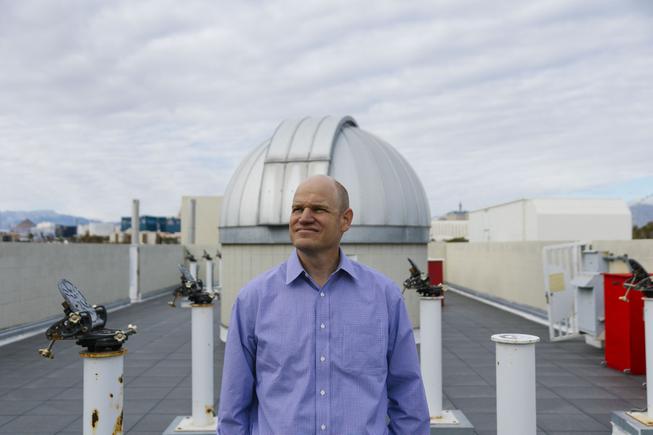
UNLV physics professor Jason Steffen, who studies exoplanets, or planets that orbit distant stars, poses for a photo on the roof of the Bigelow Physics Building at UNLV Tuesday, Dec. 28, 2021.
Friday, Dec. 31, 2021 | 2 a.m.
When the James Webb Space Telescope gets into place next month about a million miles from Earth, it will allow scientists to see the light of distant galaxies and marvel at the origins of the universe.
UNLV astrophysicist Jason Steffen will do both plus study the data the telescope sends back on the atmospheres of exoplanets, or planets that orbit other stars. Exoplanet study is another key part of the Webb mission and is Steffen’s specialty.
Since 2008 he’s been a member of the science team for NASA’s Kepler Space Telescope mission that searched for exoplanets in the Milky Way.
And he says studying those distant stars is downright fascinating.
“Being able to detect things like water, carbon dioxide, some complex molecules in the atmosphere, is going to be a pretty big deal,” said Steffen, a physics professor.
The James Webb Space Telescope, named for one of NASA’s first administrators, is a joint effort of NASA, the European Space Agency and the Canadian Space Agency. It will look relatively near, in our own solar system, and far back into space and time, capturing the light from the first galaxies in the early universe.
For NASA, Steffen works primarily with Kepler data. The Kepler telescope, set in deep space, measured the brightness variation of stars, capturing what could be orbiting planets passing through their glow. Using these Kepler observations he been part of many recent discoveries in exoplanet science — like the possibility that closely neighboring planets in the same solar system could share life.
Steffen said the Webb telescope’s Christmas day launch from French Guiana, on the northern coast of South America, went well and the telescope was transiting as expected. It should set up around Jan. 24 at a point called L2, one of five points within the Earth’s orbit where the gravitational forces of the sun and Earth can hold an object in place. Think of this as the telescope’s parking space.
He says the telescope launch carries great significance. Here’s why:
Infrared
Webb sees in the infrared region of the electromagnetic spectrum.
Electromagnetic energy travels in waves. Radio waves are long. Gamma rays are short. The human eye can only detect “visible light,” a small portion of the spectrum.
Infrared has longer wavelengths than visible light, so we can’t see it. Webb’s camera can.
People may be familiar with the Hubble Space Telescope, which launched in 1990 and is still in operation, snapping stunning, sharp images of stars, planets and galaxies in various life stages. Hubble’s camera sees primarily in visible light, though. Objects look opaque when viewed through this visible light instrument because they are obscured by dust.
“When you’re looking at a star-forming region, you’re going to have columns of cold material with a lot of dust in it,” Steffen said. “In order to see what’s going on in there, you have to look at long wavelengths so that the light can leave from the objects you study and make it through that cloud. It’s a way to look through clouds, basically, for planet formation and star formation.”
Also, when studying the furthest-away galaxies in the expanding universe, the light from the developing galaxies is lengthened — stretched out — from visible light into the infrared. This requires an infrared instrument.
Earth’s greenhouse gases — like water, carbon dioxide and methane — block infrared waves in either direction. So Webb has to get above Earth’s atmosphere to fix its more penetrating “gaze.”
Though Webb will be bigger and more sensitive, it will be complementary to Hubble, Steffen said.
Thinking big
But why would most people, who aren’t astronomers or planetary scientists, want people to study space?
Astronomy creates awe-inspiring images, which hook people and get them to pursue other sciences with practical applications here on Earth, like building bridges, Steffen said.
It also explains the physical nature of how the universe and Earth formed. It investigates how stars and other planets form. With this knowledge, people can compare other bodies to our own planet and sun. Those are pretty big existential notions too.
“The James Webb Space Telescope represents the ambition that NASA and our partners maintain to propel us forward into the future,” NASA Administrator Bill Nelson said in a statement. “The promise of Webb is not what we know we will discover; it’s what we don’t yet understand or can’t yet fathom about our universe.”
Want to follow Webb’s progress? Visit www.jwst.nasa.gov/ for more.
